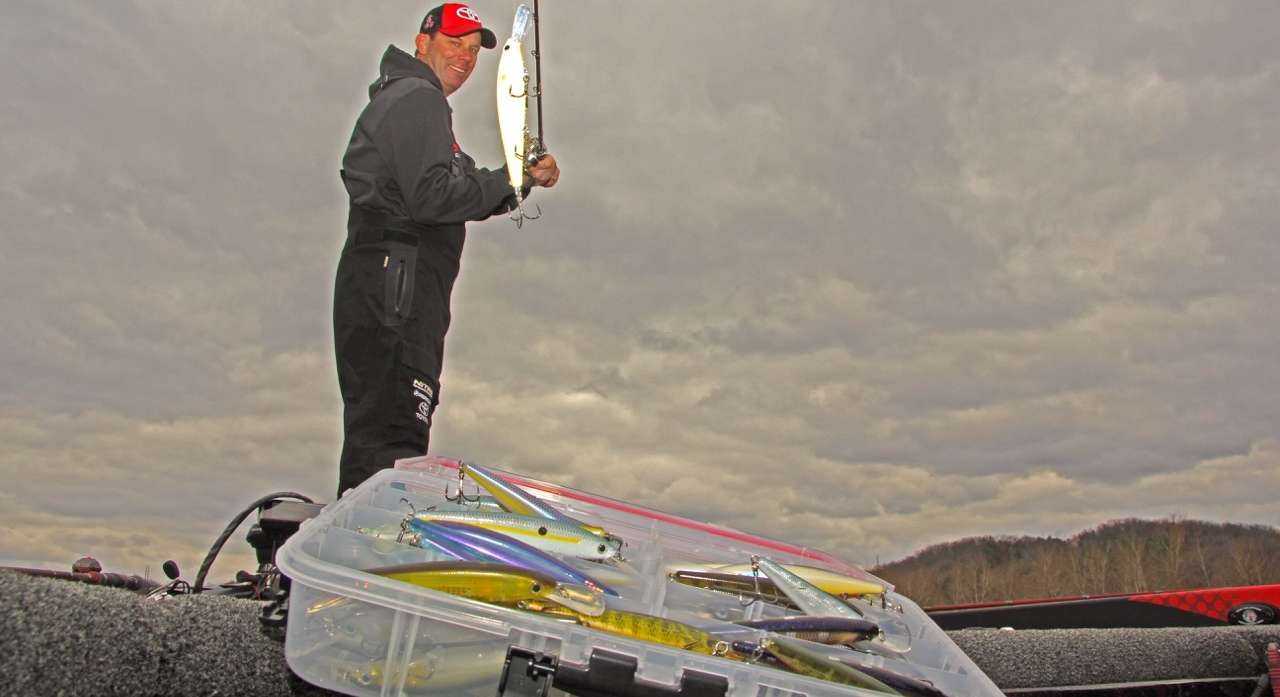
“I’ll say 15 percent – because I don’t think you can win this Classic with just one lure. You’ll have to mix it up a little.”
I love fishing a jerkbait.
It’s a lure that most anglers pigeonhole as a cold-water bait, but it’s one I use through all of the seasons.
I’ll use it throughout the summer when the bass suspend in deeper water and the water is relatively clear.
The jerkbait is a sight-oriented presentation, so you need clear water, but you also need the fish to be in a zone where they can see your bait.
That presents a problem when the fish are deep because standard jerkbaits only dive to 3 to 5 feet. Now, when I go into northern Michigan, I can pull fish out of 20 feet to hit a standard jerkbait because the water is crystal clear. But that’s not the norm for most of the nation.
That’s why I worked with Strike King to develop a deep jerkbait that targets depth zones to reach those deeper fish. The Deep Diving KVD Jerkbait that was introduced at last year’s tackle show will get to 10 feet or more on 10-pound fluorocarbon line.
Jerkbaits that get down to that depth are ideal right now for those northern and Midwestern lakes that are still under 50-degree surface temperatures.
There are times during spring on highland reservoirs that it can be good when the bass set up on shad in the main river after a heavy rain.
A crankbait might work in the situation, but I’ve encountered situations when the bass won’t react to a crankbait as well as they do a jerkbait that’s stays in a specific depth zone longer.
Another situation that works well in the summer is when you see schooling bass busting shad in a clear lake.
Deep jerkbaits are excellent tools during summers on natural lakes when the fish are relating to the outside edge of weedlines or on reservoirs when the fish are suspended around bridge pilings or rock piles.
I caught a lot of bass on our new deep jerkbait late last summer and into fall on days when the fish just wouldn’t react to a crankbait. That’s one of the reasons we built the features into the new deep jerkbait to provide an alternative to crankbaiting when the fish are deep.
For example, it has good side-to-side erratic action to trigger those bites. Also, it doesn’t pull as hard as some deep jerkbaits.
To get one to achieve these depths, you have to be able to cast it far and into the wind. This bait has an internal weight system that allows it to cast like a rocket into the wind, has a good dive angle and stay balanced when you jerk it hard.
Another difference between our deep bait and the standard model is it suspends with the nose down which helps add to the action when twitched or jerked.
Regardless of where you fish a jerkbait, always remember to utilize slack line when pulling the bait. I pop a jerkbait one to three times but always let the rod recoil back to the lure so I’m starting each jerk with slack line. That’s key to any jerkbait you use.
If the water is around 40 degrees, I will pop it hard but let it sit longer between twitches. As the water warms, I fish it harder, snatching it with the same force I would if setting the hook on a Texas-rig worm.
I throw it on my Quantum KVD Tour 6-10 medium-heavy rod and a high speed KVD reel. I never use the reel to move the bait – always with the rod; the faster reel allows me to take up slack as needed, especially when I get a strike.
So, if you haven’t added deep jerkin’ to your year-round arsenal, it’s something you need to include. It will give you another presentation for reaching depth zones that standard jerkbaits can’t achieve and catch fish that won’t react to more traditional presentations.
Remember, it’s all about the attitude!

